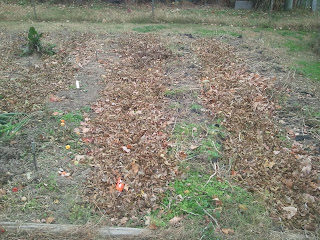This weekend was clean-up day for the garden. Plants killed by frost were ripped out and added to the compost. Tomato stakes were pulled and put away for the winter.
After all the removal, we still have a lot of edibles available. The list includes green onions, beets, red leaf lettuce, swiss chard, celeriac, arugula, collards, New Zealand spinach, kohl rabi, mustard greens, and radishes. These garden leftovers should make some tasty stir-fry and salads over the next few weeks.
Everything left has survived a couple hard frosts. These guys are tough and hardy. Once the garden inventory was complete, it was time to tackle leaves. Everyone helped, and placed the leaf harvest in the garden.
I spread the leaves in the troughs between the seedbeds, and stepped on them to compact them in and keep them from blowing around too much. My hope is that they will decompose some over the winter, turning into leaf mold that I can till into the soil. This was the first raking. There will be more leaves.
Tuesday, November 20, 2012
Thursday, November 8, 2012
Frost
Planting in late summer for an autumn harvest is a great way to extend the gardening season and keep putting tasty stuff on the supper table. Here in Central Virginia, first frost generally hits at the end of October, so as long as you can count backwards from that average frost date, and only put in things that can mature in time, you can squeeze in a second growing season.
In this recent harvest, the green beans and the sugar snap peas are from plants grown from seed that went in the ground in late August. I planted about a fourth of the garden with relay crops then, and put down clover as a cover crop a little later.
Clover is in the foreground. Starting on the right and working to the left, you can see New Zealand spinach, collard greens, arugula, snap peas, and my Kentucky Wonder bean tepee, which produced all summer and fall. Green beans are killed by frost. Peas are hardier, as are the cabbage family greens like collards and mustard greens. Earlier this week, a hard frost hit.
This was the first frost we'd had. It was 29 degrees Fahrenheit that morning.
It was cold enough for ice to form in the top of these buckets of water.
These collards look frozen, but they defrosted and perked right back up. The most important thing is to not pick anything while it is frosty, or you'll wind up with a pile of goo in your basket. Let them unthaw, and then pick. Interestingly, frost exposure generally alters the flavor of most vegetables for the good. Root crops get sweeter, and leafy greens get tastier.
Our Swiss Chard, another August planting, appears totally defeated by the frost. However, just like the collards, they warmed up and are doing just fine. Chard is extremely cold hardy. I've read that it can survive in snow. Perhaps we'll find out first-hand.
Clover is in the foreground. Starting on the right and working to the left, you can see New Zealand spinach, collard greens, arugula, snap peas, and my Kentucky Wonder bean tepee, which produced all summer and fall. Green beans are killed by frost. Peas are hardier, as are the cabbage family greens like collards and mustard greens. Earlier this week, a hard frost hit.
This was the first frost we'd had. It was 29 degrees Fahrenheit that morning.
It was cold enough for ice to form in the top of these buckets of water.
These collards look frozen, but they defrosted and perked right back up. The most important thing is to not pick anything while it is frosty, or you'll wind up with a pile of goo in your basket. Let them unthaw, and then pick. Interestingly, frost exposure generally alters the flavor of most vegetables for the good. Root crops get sweeter, and leafy greens get tastier.
Our Swiss Chard, another August planting, appears totally defeated by the frost. However, just like the collards, they warmed up and are doing just fine. Chard is extremely cold hardy. I've read that it can survive in snow. Perhaps we'll find out first-hand.
Subscribe to:
Posts (Atom)









